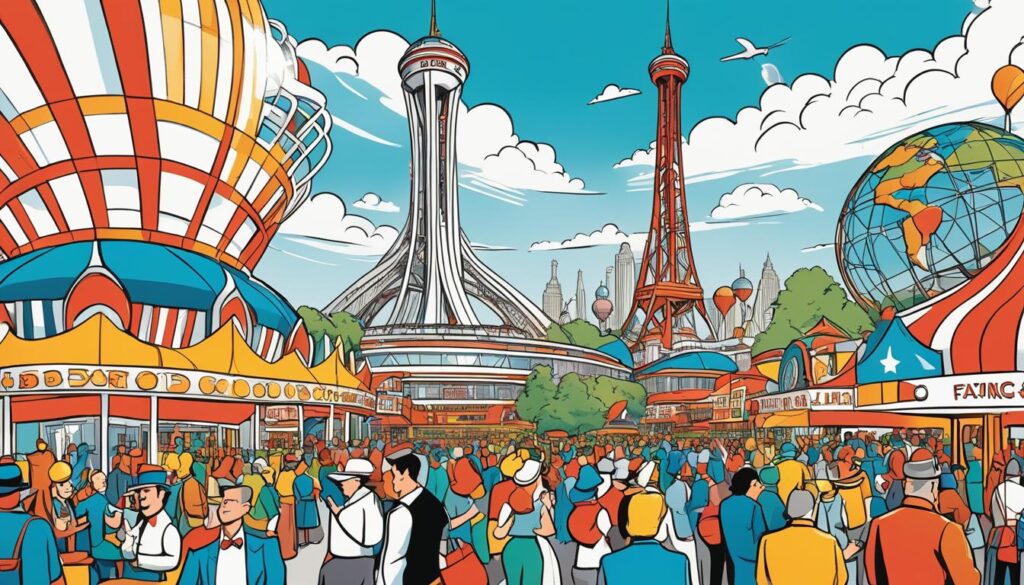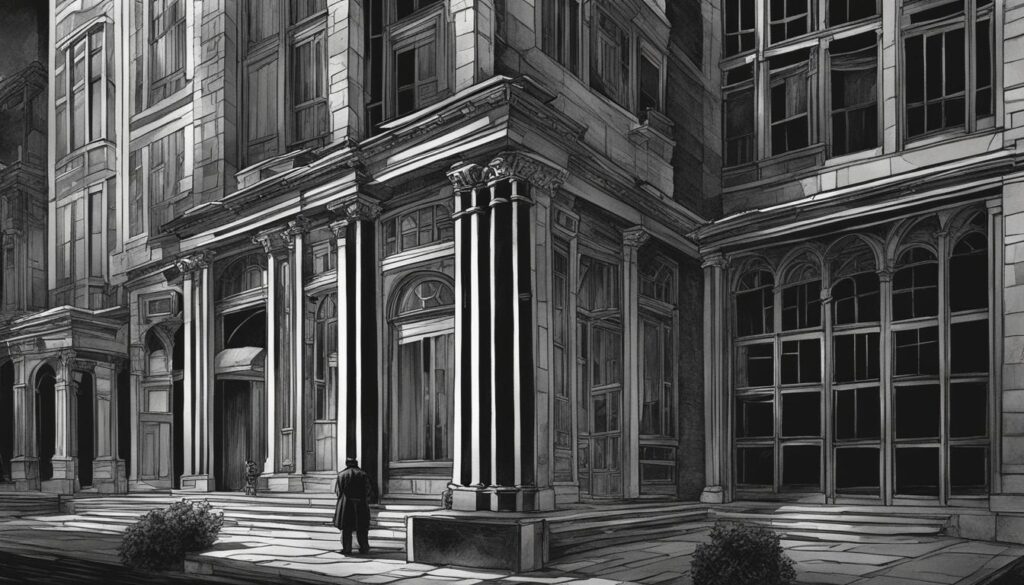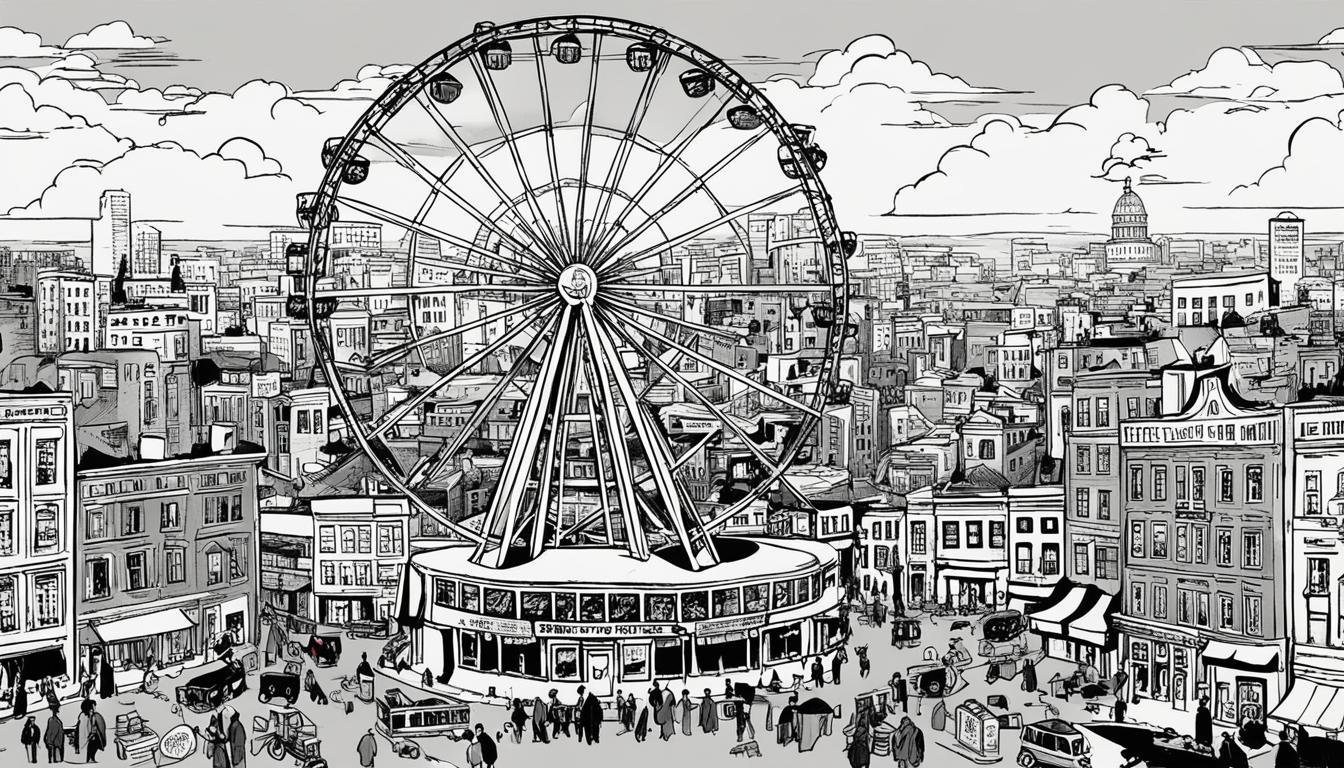The Devil in the White City, written by Erik Larson, is a non-fiction novel that captures the intertwining narratives of ambition and darkness during the 1893 Chicago World’s Fair. Through Larson’s vivid storytelling, readers are taken on a journey that uncovers the hidden secrets behind the architectural feats that brought the fair to life and the sinister events that unfolded alongside it.
Key Takeaways
- The Devil in the White City explores the fascinating history of the 1893 Chicago World’s Fair.
- The book highlights the darker side of the fair, including a series of murders that occurred during the event.
- Erik Larson’s writing style and narrative techniques make the story incredibly engaging and thrilling.
- The Devil in the White City provides critical insights into a pivotal moment in American history and its lasting impact on popular culture.
- Overall, The Devil in the White City provides a captivating and informative read for history lovers and fans of suspenseful storytelling.
Introduction to “The Devil in the White City”
Discover the enthralling story of “The Devil in the White City” by Erik Larson. This true crime novel is set during the 1893 World’s Fair in Chicago and follows the parallel stories of a brilliant architect, Daniel Burnham, and Dr. H. H. Holmes, one of America’s first serial killers.
As we delve into this fascinating tale, get ready to be transported back in time to a world of wonder and darkness. Presented with meticulous research and eloquent prose, “The Devil in the White City” captures the essence of an era and brings to life an unforgettable cast of characters.
“Erik Larson has created a blockbuster nonfiction narrative, one that not only tells a fascinating story but also offers a wonderful window into a pivotal moment in history.”
Background and Setting
The Devil in the White City is set against the backdrop of late 19th century America, a time of great industrial growth and innovation. Against this dynamic setting, author Erik Larson weaves a gripping tale of ambition, power, and darkness.
The book takes place primarily in Chicago, Illinois, during a time when the city was rapidly becoming an industrial powerhouse. As Larson writes, “Chicago had a strange theatricality about it, a sense that reality itself was up for invention and reinvention.”
It is against this unique backdrop that Larson sets his tale of two men – architect and visionary Daniel Burnham, and serial killer H.H. Holmes – whose lives become intertwined in surprising ways. As readers delve deeper into the narrative, they are taken on a journey through the heart of America’s Gilded Age, with all of its glamour, intrigue, and darkness.
Main Characters
“The Devil in the White City” is a riveting story that would not be complete without its cast of compelling characters. Below we highlight a few of the primary figures:
| Character | Description |
|---|---|
| Daniel Burnham | An architect and the director of works for the World’s Columbian Exposition in Chicago. |
| H. H. Holmes | A charming serial killer who constructed a hotel specifically for the purpose of preying on unsuspecting guests. |
| Frederick Law Olmsted | A landscape architect who worked on many notable projects, including Central Park in New York City. |
| John Root | Another architect who worked alongside Burnham on the World’s Fair. |
The Devil in the White City masterfully weaves the lives of these and other characters into a thrilling narrative that showcases both their accomplishments and their darker sides.
The World’s Fair
The World’s Columbian Exposition, commonly known as the World’s Fair, was one of the most significant events in 19th century America. Held in Chicago between May and October 1893, the fair commemorated 400 years since Christopher Columbus’s arrival in the New World and showcased the latest advancements in art, culture, technology, and architecture.
The World’s Fair attracted over 27 million visitors, driving Chicago’s tourism and boosting the city’s reputation as a hub of innovation and progress. Some of the most iconic attractions included the Ferris wheel – the largest ever built at the time – and the “White City,” a collection of over two hundred neoclassical buildings illuminated by electric lights, which inspired awe and wonder among visitors.
The fair’s impact extended beyond tourism and entertainment. It marked a turning point for Chicago and the United States, as it symbolized the country’s emergence as a global superpower and its rise to modernity. The World’s Fair showcased America’s technological and industrial prowess, reinforcing the country’s image as a beacon of growth and progress.
However, as Erik Larson’s “The Devil in the White City” reveals, the World’s Fair was not without its dark side. The book explores the disturbing events and characters that emerged during the fair, exposing a side of Chicago that was plagued by crime, corruption, and deception.

“The creaky world of medicine and care, science and growth, all went on in secret, as it had before and would for years to come. Patients came and went, attended to by doctors from the fair and beyond whose skills and training varied widely. Visitors to the clinic, some badly ill, walked the floors marveling at the displays outside, scrimping for the nickel admission charge, never aware of the lives that hung tenuously near theirs, or of the political fighting and controversy that swirled around the little building.” – Erik Larson
Architectural Feats
The architectural feats showcased in “The Devil in the White City” are nothing short of breathtaking. From the stunning neoclassical facades of the White City to the innovative designs of the Ferris Wheel, these structures captured the imagination of audiences and represented a new era of architectural achievement.
Perhaps the most iconic example of these feats is the grand entrance to the World’s Fair, which welcomed visitors with a magnificent archway adorned with intricate sculptures and classical motifs. This structure was a testament to the power and grandeur of the event, setting the tone for the awe-inspiring experiences that awaited attendees.
Another notable example is the Ferris Wheel, a revolutionary attraction that introduced a new era of structural design. This impressive feat of engineering stood 264 feet tall and boasted 36 passenger cars, each of which could hold up to 60 people. Its popularity inspired a wave of imitators around the world, cementing its place in history as a true architectural marvel.
These architectural achievements not only served as stunning visual spectacles but also represented a larger cultural shift towards innovation and progress. By pushing the boundaries of what was possible, they helped to shape the identity of the era and inspire future generations.
The Dark Side Unveiled
While “The Devil in the White City” showcases the impressive feats of architecture and innovation that came out of Chicago in the late 1800s, it also unveils a darker side of the city that is both unsettling and chilling. Among the most disturbing elements of the book are the sinister characters who lurk in the shadows, preying on unsuspecting victims.
One such figure is H.H. Holmes, a notorious serial killer who operated a “murder castle” during the time of the World’s Fair. Holmes used his charm and devious mind to lure women to his hotel, where he tortured, killed, and dismembered them. His shocking crimes added a layer of horror to an already macabre story, revealing the true darkness that lies beneath the surface of progress and prosperity.
“I was born with the devil in me,” Holmes once said. “I could not help the fact that I was a murderer, no more than the poet can help the inspiration to sing.”
The Murder Castle
Holmes’s “murder castle” was a building he designed specifically to lure victims to their deaths. The hotel featured trapdoors, gas chambers, hidden rooms, and other horrors that allowed Holmes to trap and kill with ease. In the basement of the building, he had a kiln that he used to dispose of his victims’ bodies.
The macabre details of Holmes’s crimes are shocking and disturbing, but they shed light on the darkness that lurked beneath the shiny exterior of the World’s Fair and the city of Chicago as a whole. Their inclusion in “The Devil in the White City” serves as a reminder that progress and prosperity often come at a steep cost.
The Murders
The World’s Fair, a grand celebration of innovation and human progress, was the perfect cover for one of the most macabre events in Chicago’s history – a string of gruesome murders. The murders were committed by H.H. Holmes, a seemingly charming and successful businessman who used his charisma to lure young women into his “Murder Castle”.
Throughout the fair, Holmes preyed on women, using his hotel to abduct and kill them with intricate methods that included gas chambers and dissection tables. His true nature was finally unveiled when a caretaker discovered a decomposing corpse in the basement of the hotel, leading to the discovery of a chamber of horrors with remains of at least 27 victims.
The murders sent shockwaves through the city and had a profound impact on the story of “The Devil in the White City”. They showcased the darkness that lurked beneath the surface of progress and innovation, highlighting the fragility of life and the dangers of unchecked ambition.
“I was born with the devil in me. I could not help the fact that I was a murderer, no more than the poet can help the inspiration to sing – I was born with the Evil One standing as my sponsor beside the bed where I was ushered into the world, and he has been with me since.” – H.H. Holmes
Investigation and Justice
Following the murders that shook the World’s Fair, a rigorous investigation took place in an attempt to bring justice to the victims and their families. The Chicago police department worked tirelessly, gathering evidence and interviewing witnesses to uncover the truth behind the heinous crimes. The investigation was a long and arduous process, spanning several months and involving many individuals.
The pursuit of justice was paramount to the investigators and the city as a whole. The murders had a profound impact on the community, sparking fear and uncertainty among residents. It was essential to solve the case to restore a sense of safety and security to the city.

The investigation ultimately resulted in the arrest and conviction of serial killer and architect H.H. Holmes, who was responsible for the murders. His capture and punishment brought a sense of closure to the case and marked a turning point for justice in America.
Key Players in the Investigation
| Role | Name |
|---|---|
| Lead Investigator | Frank Geyer |
| Chief of Police | William Pinkerton |
| Prosecutor | George Graham |
| Defense Attorney | William Scholl |
The investigation was a complex undertaking that required the expertise and dedication of many individuals. Some of the key players involved in the case included lead investigator Frank Geyer, Chief of Police William Pinkerton, prosecutor George Graham, and defense attorney William Scholl.
Themes and Symbolism
As with any great literary work, “The Devil in the White City” encompasses various themes and symbols that add depth and complexity to the narrative. One of the most prominent themes in the book is the ambitious spirit that drives many of the characters, from the architects and builders of the World’s Fair to the notorious serial killer, H.H. Holmes. This ambition is often portrayed as both a positive and negative force, showcasing its ability to drive innovation and progress, while also leading to greed and corruption.
Another notable theme in the book is the exploration of the human psyche, particularly in relation to darkness and evil. The narrative is marked by a number of disturbing events and characters, including the gruesome murders committed by Holmes, that delve into the darker side of the human experience. This theme is further underscored by the use of imagery and symbolism throughout the book, such as the recurring motifs of the “White City” and the “Black City,” which represent the contrast between light and darkness, order and chaos.
Overall, the themes and symbolism present in “The Devil in the White City” add depth and nuance to the narrative, inviting readers to contemplate larger questions about ambition, morality, and the human experience.
Historical Significance
“The Devil in the White City” is not only a captivating true crime story but also a significant documentation of Chicago’s history and the United States at the turn of the 20th century. The book offers a fascinating glimpse into the creation of the World’s Fair and its impact on the city and the nation’s cultural landscape.
Erik Larson’s meticulous research and attention to detail shed light on important historical topics, such as urbanization, immigration, politics, and technological innovations that shaped the United States during this period. In addition, “The Devil in the White City” highlights critical issues such as social inequality, government corruption, and the power of the press.
This book is a valuable resource for historians, scholars, and anyone interested in understanding the cultural significance of the World’s Fair and its connection to the larger historical context.
Literary Style and Narrative Techniques
Erik Larson’s “The Devil in the White City” is a masterfully crafted work of historical fiction that weaves together two distinct storylines set against the backdrop of the 1893 World’s Columbian Exposition in Chicago. Larson’s literary style and narrative techniques contribute greatly to the book’s overall reading experience, pulling readers into the stories and immersing them in the atmosphere of the time.
One of the most striking aspects of Larson’s style is his ability to create intricate, multi-layered narratives that bring together numerous characters, settings, and plotlines in a cohesive and compelling way. He masterfully juggles the stories of Daniel Burnham, the chief architect of the World’s Fair, and H.H. Holmes, a notorious serial killer who used the fair to lure his victims. By deftly shifting between these two stories, Larson creates a sense of suspense and intrigue that keeps readers engaged from start to finish.
Larson’s use of historical detail and research is also a standout element of his style. He deftly blends real-life events, figures, and artifacts into the narrative, painting a vivid picture of life in Chicago during this time period. From the sprawling architecture of the World’s Fair to the gritty streets of the city, readers are transported to another time and place through Larson’s descriptive prose.
In terms of narrative techniques, Larson’s use of foreshadowing and pacing is particularly effective. He drops hints and clues throughout the book that build tension and anticipation for the shocking climax, while keeping the pace brisk and engaging. His vivid characterizations of the book’s main players also add depth and complexity to the story, making it more than just a tale of good versus evil.
In conclusion, Erik Larson’s literary style and narrative techniques are integral to the success of “The Devil in the White City.” Through his intricate plotting, masterful use of historical detail, and engaging pacing, Larson has created a work of historical fiction that is both informative and entertaining.
Critical Reception and Impact
Since its release in 2003, “The Devil in the White City” has received widespread critical acclaim for its gripping storytelling and meticulous historical research. The book has been praised for its ability to weave together two distinct storylines into a compelling and cohesive narrative, showcasing Erik Larson’s impressive writing skills.
The book’s impact on popular culture has been significant, with many readers citing it as a favorite and recommending it to others. It has been translated into over 17 languages and has sold millions of copies worldwide. “The Devil in the White City” also inspired a number of spin-off works, including a board game and an upcoming Hulu television series.
Awards and Honors
| Award/Honor | Year |
|---|---|
| National Book Award | 2003 |
| Edgar Award for Best Fact Crime | 2004 |
| Publishers Weekly Best Book of the Year | 2003 |
| New York Times Bestseller | 2003 |
| Chicago Tribune Best Book of the Year | 2003 |
Erik Larson’s “The Devil in the White City” has left an indelible imprint on the literary world and beyond. Its critical reception and lasting impact are a testament to the enduring power of narrative storytelling and the importance of capturing historical moments with accuracy and flair.
Conclusion
In conclusion, “The Devil in the White City” by Erik Larson is a gripping narrative that intertwines ambition and darkness. The book explores the historical background and setting of Chicago in the late 19th century, focusing on the World’s Fair and the chilling murders that took place during the event. Through impressive architectural feats and engaging characters, Larson captures the essence of this time period and sheds light on pivotal moments in the city’s history and the nation as a whole.
With its impactful themes and symbolism, literary style, and narrative techniques, “The Devil in the White City” has captured the attention of readers and critics alike, leaving a lasting impact on popular culture. It remains a must-read for anyone interested in history, true crime or captivating storytelling.
Overall, this article has provided a concise summary of the book, introduced its notable characters, and delved into its historical significance and cultural impact. We hope that our exploration of “The Devil in the White City” will inspire readers to delve into the book and experience the chilling narrative for themselves.



